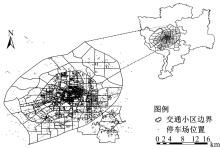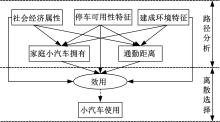吉林大学学报(工学版) ›› 2019, Vol. 49 ›› Issue (3): 714-719.doi: 10.13229/j.cnki.jdxbgxb20180047
考虑停车可用性的建成环境对小汽车通勤出行的影响
- 1. 北京交通大学 城市交通复杂系统理论与技术教育部重点实验室,北京 100044
2. 北京交通大学 综合交通运输大数据应用技术交通运输行业重点实验室,北京 100044
Influence of urban built environment on car commuting considering parking availability
Chao⁃ying YIN1( ),Chun⁃fu SHAO2(
),Chun⁃fu SHAO2( ),Xiao⁃quan WANG1
),Xiao⁃quan WANG1
- 1. MOE Key Laboratory for Urban Transportation Complex Systems Theory and Technology, Beijing Jiaotong University, Beijing 100044, China
2. Key Laboratory of Transport Industry of Big Data Application Technologies for Comprehensive Transport, Beijing Jiaotong University, Beijing 100044, China
摘要:
为分析建成环境对通勤出行方式选择的影响,考虑居住地和工作地的停车可用性,以小汽车拥有和通勤距离为中介变量,构建路径分析?离散选择一体化模型(PAM?DCM)。利用长春市居民出行调查数据,借助Mplus软件对模型参数进行估计,并与不考虑停车可用性的情况进行比较。研究结果表明,考虑停车可用性的模型拟合效果更优,且停车可用性对小汽车通勤具有显著的正效应;建成环境对小汽车通勤有显著影响,且居住地建成环境的影响大于工作地。
中图分类号:
- U491
| 1 | 秦焕美,关宏志,殷焕焕. 停车收费价格对居民出行方式选择行为的影响研究——以北京市居民小汽车、公交、出租车选择行为为例[J]. 土木工程学报,2008,41(8):93⁃98. |
| QinHuan⁃mei,GuanHong⁃zhi,YinHuan⁃huan. A study of the effect of parking price on the mode of inhabitant trip behavior—with the cars, public transit and taxi in Beijing as an example[J]. China Civil Engineering Journal,2008,41(8):93⁃98. | |
| 2 | 丁川,林姚宇,王耀武. 城市空间扩张与机动化水平增长之间的互动关系探究[J]. 交通运输系统工程与信息,2014,14(3):9⁃15. |
| DingChuan,LinYao⁃yu,WangYao⁃wu. Interactive relationship between urban spatial expansion and mobility growth in China[J]. Journal of Transportation Systems Engineering & Information Technology,2014,14(3):9⁃15. | |
| 3 | PetterChristiansen, ØysteinEngebretsen, NilsFearnley, et al. Parking facilities and the built environment: Impacts on travel behavior[J]. Transportation Research Part A: Policy & Practice,2017,95:198⁃206. |
| 4 | GuerraE. The built environment and car use in Mexico city: is the relationship changing over time?[J]. Journal of Planning Education & Research,2014,34(4):394⁃408. |
| 5 | LiSheng⁃xiao, ZhaoPeng⁃jun. Exploring car ownership and car use in neighborhoods near metro stations in Beijing: does the neighborhood built environment matter?[J]. Transportation Research Part D: Transport & Environment,2017,56:1⁃17. |
| 6 | ShirgaokarM. Expanding cities and vehicle use in India: differing impacts of built environment factors on scooter and car use in Mumbai[J]. Urban Studies,2016,53(15):3296⁃3316. |
| 7 | SunB, ErmagunA, DanB. Built environmental impacts on commuting mode choice and distance: evidence from Shanghai[J]. Transportation Research Part D: Transport & Environment,2017,52:441⁃453. |
| 8 | JiangYang, GuPei⁃qin, ChenYu⁃lin, et al. Influence of land use and street characteristics on car ownership and use: evidence from Jinan, China[J]. Transportation Research Part D: Transport & Environment,2017,52:518⁃534. |
| 9 | 曹新宇. 社区建成环境和交通行为研究回顾与展望:以美国为鉴[J]. 国际城市规划,2015,30(4):46⁃52. |
| CaoXin⁃yu. Examining the relationships between neighborhood built environment and travel behavior: a review from US perspective[J]. Urban Planning International,2015,30(4):46⁃52. | |
| 10 | ReidE, RobertC. Travel and the built environment[J]. Journal of the American Planning Association,2010,76(3):265⁃294. |
| 11 | CaoXiao⁃shu, YangWen⁃yue. Examining the effects of the built environment and residential self⁃selection on commuting trips and the related CO2, emissions: an empirical study in Guangzhou, China[J]. Transportation Research Part D: Transport & Environment,2017,52:480⁃494. |
| 12 | WangXiao⁃quan, ShaoChun⁃fu, YinChao⁃ying, et al. Application of Bayesian multilevel models using small and medium size city in China: the case of Changchun[J]. Sustainability,2018,10(2):1⁃15. |
| [1] | 白乔文,曲昭伟,陈永恒,熊帅,陶楚青. 非严格优先权下无左转专用相位直行车辆轨迹模型建立[J]. 吉林大学学报(工学版), 2019, 49(3): 673-679. |
| [2] | 李志慧,钟涛,赵永华,胡永利,李海涛,赵景伟. 面向车辆自主驾驶的行人跟踪算法[J]. 吉林大学学报(工学版), 2019, 49(3): 680-687. |
| [3] | 曹宁博,赵利英,曲昭伟,陈永恒,白乔文,邓晓磊. 考虑双向行人跟随行为的社会力模型[J]. 吉林大学学报(工学版), 2019, 49(3): 688-694. |
| [4] | 罗小芹,王殿海,金盛. 面向混合交通的感应式交通信号控制方法[J]. 吉林大学学报(工学版), 2019, 49(3): 695-704. |
| [5] | 陈磊,王江锋,谷远利,闫学东. 基于思维进化优化的多源交通数据融合算法[J]. 吉林大学学报(工学版), 2019, 49(3): 705-713. |
| [6] | 凃强,程琳,林芬,孙超. 考虑出行者风险态度的最优路径搜索[J]. 吉林大学学报(工学版), 2019, 49(3): 720-726. |
| [7] | 陈永恒,刘芳宏,曹宁博. 信控交叉口行人与提前右转机动车冲突影响因素[J]. 吉林大学学报(工学版), 2018, 48(6): 1669-1676. |
| [8] | 常山,宋瑞,何世伟,黎浩东,殷玮川. 共享单车故障车辆回收模型[J]. 吉林大学学报(工学版), 2018, 48(6): 1677-1684. |
| [9] | 曲大义,杨晶茹,邴其春,王五林,周警春. 基于干线车流排队特性的相位差优化模型[J]. 吉林大学学报(工学版), 2018, 48(6): 1685-1693. |
| [10] | 宗芳, 齐厚成, 唐明, 吕建宇, 于萍. 基于GPS数据的日出行模式-出行目的识别[J]. 吉林大学学报(工学版), 2018, 48(5): 1374-1379. |
| [11] | 刘翔宇, 杨庆芳, 隗海林. 基于随机游走算法的交通诱导小区划分方法[J]. 吉林大学学报(工学版), 2018, 48(5): 1380-1386. |
| [12] | 钟伟, 隽志才, 孙宝凤. 不完全网络的城乡公交一体化枢纽层级选址模型[J]. 吉林大学学报(工学版), 2018, 48(5): 1387-1397. |
| [13] | 刘兆惠, 王超, 吕文红, 管欣. 基于非线性动力学分析的车辆运行状态参数数据特征辨识[J]. 吉林大学学报(工学版), 2018, 48(5): 1405-1410. |
| [14] | 宗芳, 路峰瑞, 唐明, 吕建宇, 吴挺. 习惯和路况对小汽车出行路径选择的影响[J]. 吉林大学学报(工学版), 2018, 48(4): 1023-1028. |
| [15] | 栾鑫, 邓卫, 程琳, 陈新元. 特大城市居民出行方式选择行为的混合Logit模型[J]. 吉林大学学报(工学版), 2018, 48(4): 1029-1036. |
|



